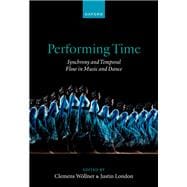Music and dance can change our sense of time. Both rely on synchronizing our attention and actions with sounds and with other people, both involve memory and expectation, and both can give rise to experiences of flow and pleasure.
Performing Time explores our experience of time in dance and music, from the perspectives of performers and audiences, and informed by the most recent research in dance science, musicology, neuroscience, and psychology. It includes discussions of tempo and pacing, coordination and synchrony, the performer's experience of time, audiences' temporal expectations, the effect of extreme slowness, and our individual versus collective senses of time. At its core, the book addresses how time and temporality in music and dance relate to current psychological and neuroscientific theories as well as to the aesthetic aims of composers, choreographers and performers.
Bringing together new research on rhythm, time and temporality in both music and dance in one volume, the book contains overview chapters on the state of the art from leading researchers on topics ranging from the psychology, neuroscience, and philosophy of musical time to embodied timing in dance. In addition, numerous case studies regarding our temporal experience of music and dance are provided in shorter focus chapters, with their implications for further scientific study and artistic enquiry.
Performing Time is an invaluable and comprehensive resource for students, researchers, educators, and artists alike, and for any reader interested in how the performing arts construct and play with time in our minds and bodies.
Some chapters in this title are open access and available under the terms of a [CC BY-NC-ND 4.0 International] licence.








